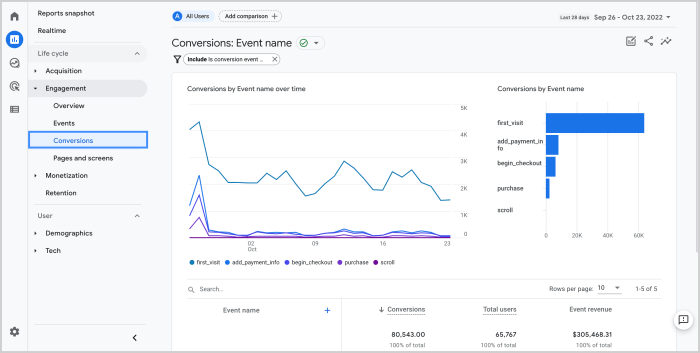Using Google Analytics to Track Conversions sets the stage for this enthralling narrative, offering readers a glimpse into a story that is rich in detail with american high school hip style and brimming with originality from the outset.
Google Analytics is more than just tracking visits; it’s about understanding how those visits lead to conversions that matter for your business. Dive into the world of conversion tracking and discover the power of data-driven decision-making.
Overview of Google Analytics Conversion Tracking: Using Google Analytics To Track Conversions
Conversion tracking in Google Analytics is the process of measuring and analyzing the actions that users take on a website that lead to a desired outcome, such as making a purchase, signing up for a newsletter, or filling out a contact form. By tracking conversions, businesses can gain valuable insights into the effectiveness of their marketing campaigns, website design, and overall user experience.
Importance of Tracking Conversions for Businesses
- Optimizing Marketing Strategies: Conversion tracking allows businesses to identify which marketing channels are driving the most conversions, enabling them to allocate resources effectively.
- Improving User Experience: By analyzing conversion data, businesses can make informed decisions to enhance the user experience on their website, leading to higher conversion rates.
- Measuring ROI: Tracking conversions helps businesses calculate the return on investment for their marketing efforts and determine the most cost-effective strategies.
Examples of Different Types of Conversions that can be Tracked
- Purchase Conversions: Tracking the number of completed purchases on an e-commerce website.
- Lead Conversions: Monitoring the number of sign-ups or inquiries made by potential customers.
- Form Submission Conversions: Tracking the submission of contact forms or request forms on a website.
Setting Up Conversion Tracking
To set up conversion tracking in Google Analytics, follow these steps:
Types of Goals for Tracking Conversions
- Create a new goal in Google Analytics by navigating to the Admin section and selecting Goals under the View column.
- Choose the type of goal you want to track, such as destination, duration, pages/screens per session, or event.
- Set up the specific details for the goal, including the destination URL, time duration, or event conditions.
- Save the goal and start tracking conversions based on the criteria you have set.
Role of Tracking Codes for Conversion Tracking
- Tracking codes, also known as conversion tracking tags, are snippets of code provided by Google Analytics to track specific actions on your website.
- These codes are implemented on the pages where you want to track conversions, such as the thank you page after a purchase or a form submission confirmation page.
- By adding the tracking codes to your website, Google Analytics can capture data on conversions and provide insights into the effectiveness of your marketing efforts.
Analyzing Conversion Data

To effectively analyze conversion data in Google Analytics, it is essential to understand the metrics and key performance indicators (KPIs) used to measure the success of your conversions. By diving into reports and dashboards, you can gain valuable insights into the performance of your conversion tracking efforts.
Metrics and KPIs for Conversions, Using Google Analytics to Track Conversions
- Conversion Rate: This metric represents the percentage of website visitors who completed a desired action, such as making a purchase or signing up for a newsletter.
- Goal Completions: The total number of times a specific goal, like submitting a contact form, has been achieved on your site.
- Revenue: The amount of money generated from conversions, providing valuable insights into the financial impact of your marketing efforts.
- Conversion Value: Assigning a monetary value to each conversion helps in understanding the overall value of different conversion actions.
Reports and Dashboards for Analysis
- Conversion Overview Report: Provides a high-level summary of your conversion data, including total conversions, conversion rates, and revenue generated.
- Goal Completion Report: Offers detailed insights into individual goals, tracking the completion rates and performance of each specific goal on your site.
- Multi-Channel Funnels Report: Shows how different channels contribute to conversions, allowing you to optimize your marketing strategies across various touchpoints.
- Attribution Modeling: Helps in understanding the impact of different marketing channels on conversions, enabling you to allocate resources effectively.
Optimizing Conversion Rates

When it comes to optimizing conversion rates based on Google Analytics data, it’s important to analyze the information provided and make strategic decisions to improve performance. By utilizing the insights gained from tracking conversions, businesses can make data-driven adjustments to their websites or marketing strategies to increase the likelihood of conversions.
A/B Testing for Improved Conversions
A/B testing is a powerful tool that can be used to experiment with different variations of a website or marketing campaign to determine which one performs better in terms of conversions. By testing different elements such as headlines, call-to-action buttons, or page layouts, businesses can identify what resonates most with their audience and optimize for better results.
- Set up A/B tests in Google Analytics to compare the performance of different versions of a webpage or ad.
- Monitor key metrics such as conversion rate, bounce rate, and average session duration to determine the most effective variation.
- Implement the changes that lead to higher conversion rates and continue testing to further optimize performance.
Identifying and Addressing Conversion Bottlenecks
It’s crucial to identify any bottlenecks in the conversion process that may be hindering the overall performance. By pinpointing areas where users are dropping off or not completing the desired actions, businesses can make targeted improvements to streamline the conversion process and increase the chances of conversions.
Use Google Analytics reports to identify pages with high bounce rates or low conversion rates, as these may indicate potential bottlenecks in the conversion funnel.
- Optimize landing pages to ensure they are clear, compelling, and align with user expectations.
- Simplify the checkout process by reducing steps, eliminating distractions, and offering multiple payment options.
- Consider implementing retargeting strategies to re-engage users who have shown interest but did not convert initially.
